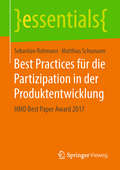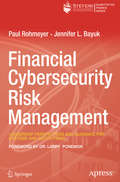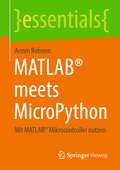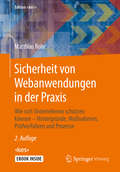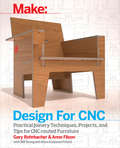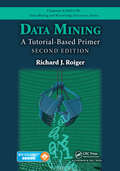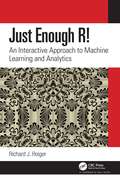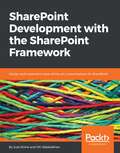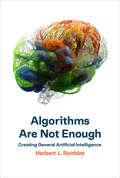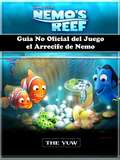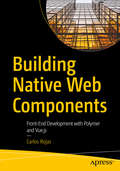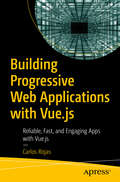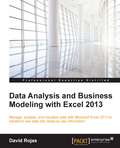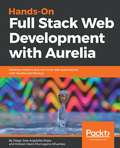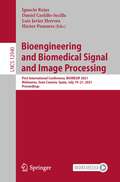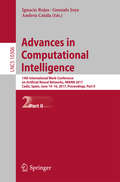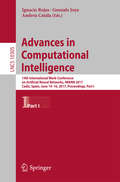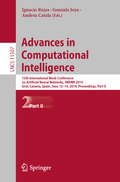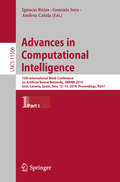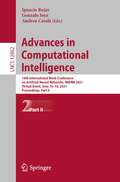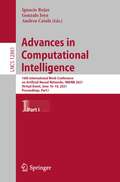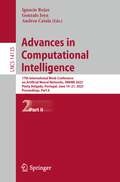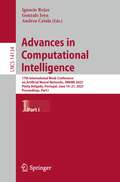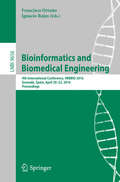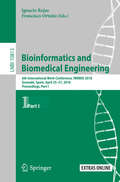- Table View
- List View
Best Practices für die Partizipation in der Produktentwicklung: HMD Best Paper Award 2017 (essentials)
by Sebastian Rohmann Matthias SchumannUnternehmen haben das Innovationspotenzial der eigenen Mitarbeiter auch außerhalb der F&E-Abteilung erkannt und eigene unternehmensinterne Innovations-Communities, auf Basis sog. Enterprise-Social-Software-Plattformen (ESSPs), implementiert. Viele Initiativen scheitern in der Praxis jedoch häufig aufgrund einer fehlenden oder zu geringen Partizipation der Mitarbeiter. Die mit den Maßnahmen erhofften Ziele werden dadurch oft nicht erreicht. In diesem essential werden die wesentlichen Problemfelder der mitarbeiterzentrierten Produktentwicklung beschrieben und Handlungsempfehlungen aus der Praxis aufgezeigt. Die AutorenSebastian Rohmann war wissenschaftlicher Mitarbeiter sowie Doktorand an der Professur für Anwendungssysteme und E-Business der Universität Göttingen und ist nun als strategischer Projektmanager tätig.Prof. Dr. Matthias Schumann ist Inhaber der Professur für Anwendungssysteme und E-Business an der Universität Göttingen.
Financial Cybersecurity Risk Management: Leadership Perspectives and Guidance for Systems and Institutions
by Paul Rohmeyer Jennifer L. BayukUnderstand critical cybersecurity and risk perspectives, insights, and tools for the leaders of complex financial systems and markets. This book offers guidance for decision makers and helps establish a framework for communication between cyber leaders and front-line professionals. Information is provided to help in the analysis of cyber challenges and choosing between risk treatment options.Financial cybersecurity is a complex, systemic risk challenge that includes technological and operational elements. The interconnectedness of financial systems and markets creates dynamic, high-risk environments where organizational security is greatly impacted by the level of security effectiveness of partners, counterparties, and other external organizations. The result is a high-risk environment with a growing need for cooperation between enterprises that are otherwise direct competitors. There is a new normal of continuous attack pressures that produce unprecedented enterprise threats that must be met with an array of countermeasures. Financial Cybersecurity Risk Management explores a range of cybersecurity topics impacting financial enterprises. This includes the threat and vulnerability landscape confronting the financial sector, risk assessment practices and methodologies, and cybersecurity data analytics. Governance perspectives, including executive and board considerations, are analyzed as are the appropriate control measures and executive risk reporting.What You’ll LearnAnalyze the threat and vulnerability landscape confronting the financial sectorImplement effective technology risk assessment practices and methodologiesCraft strategies to treat observed risks in financial systemsImprove the effectiveness of enterprise cybersecurity capabilitiesEvaluate critical aspects of cybersecurity governance, including executive and board oversightIdentify significant cybersecurity operational challengesConsider the impact of the cybersecurity mission across the enterpriseLeverage cybersecurity regulatory and industry standards to help manage financial services risksUse cybersecurity scenarios to measure systemic risks in financial systems environmentsApply key experiences from actual cybersecurity events to develop more robust cybersecurity architecturesWho This Book Is For Decision makers, cyber leaders, and front-line professionals, including: chief risk officers, operational risk officers, chief information security officers, chief security officers, chief information officers, enterprise risk managers, cybersecurity operations directors, technology and cybersecurity risk analysts, cybersecurity architects and engineers, and compliance officers
MATLAB® meets MicroPython: Mit MATLAB® Mikrocontroller nutzen (essentials)
by Armin RohnenDieses essential behandelt die Verknüpfung von MicroPython betriebenen Mikrocontroller mit MATLAB®. Anhand eines Praxisbeispiels werden die Aspekte der Planung, der elektronischen Umsetzung, der Programmierung in MicroPython, die Programmierung in MATLAB® und die Erstellung einer graphischen Oberfläche handelt.
Sicherheit von Webanwendungen in der Praxis: Wie Sich Unternehmen Schu?tzen Ko?nnen -- Hintergru?nde, Maßnahmen, Pru?fverfahren Und Prozesse (Edition Kes Ser.)
by Matthias RohrWebanwendungen bilden in Unternehmen zahlreiche sensible Geschäftsprozesse ab – ob mit Kunden, mit Mitarbeitern, Partnern und Zulieferern. Daher sind Webapplikationen ein Sicherheitsrisiko für Unternehmen und ihr Schutz von entscheidender Bedeutung. In dem Buch beleuchtet der Autor die wichtigsten Aspekte der Webanwendungssicherheit und stützt sich dabei auf seine langjährige Erfahrung als IT-Security-Berater für Webanwendungen und Entwicklungsprozesse.Der Band bietet neben einem allgemeinen Überblick zum Thema Sicherheit von Webanwendungen ausführliche und praxisorientierte Darstellungen zu wichtigen Einzelfragen: Was sind die häufigsten Schwachstellen und mit welchen Maßnahmen lassen sich Webanwendungen am effektivsten gegen Angriffe absichern? Ein eigenes Kapitel befasst sich mit den Verfahren, die eingesetzt werden, um die Sicherheit von Anwendungen bereits im Entwicklungsprozess zu bewerten und zu überprüfen. Der Autor erläutert zudem, wie sich die Sicherheit in selbst entwickelten und zugekauften Webanwendungen durch organisatorische Prozesse nachhaltig verbessern lässt.Die zweite Auflage des 2014 erstmals erschienen Buchs wurde vor dem Hintergrund neuer Techniken zur Abwehr von Angriffen und neuer Prüfverfahren vollständig überarbeitet und aktualisiert. Auch aktuelle Beratungsprojekte des Autors haben Eingang in die Neuauflage gefunden – insbesondere dort, wo es um organisatorische Aspekte von Webanwendungssicherheit geht.Der Band richtet sich an Entwickler von Webanwendungen, IT-Security- und Qualitätsmanager genauso wie an Leser, die sich in das Thema Webanwendungssicherheit einarbeiten wollen.
Design for CNC: Practical Joinery Techniques, Projects, and Tips for CNC-Routed Furniture
by Gary Rohrbacher Anne Filson Anna Kaziunas France Bill YoungDesign, DIY, and computer-controlled fabrication are a powerful combination for making high-quality customized things. Written by the founders of the architecture, design, and research firm Filson and Rohrbacher, this book takes you through the basics of CNC fabrication, the design process, production, and construction of your own furniture designs. Through their AtFAB series of projects, accompanied by an overview of digital techniques and design thinking, this book introduces the knowledge and skills that you'll find widely applicable across all kinds of CNC projects. Not only will you learn how to design, fabricate, and assemble a wide range of projects, you'll have some great furniture to show for it! While 3D printing has been grabbing headlines, high school, college, library, and other public makerspaces have been making things with CNC machines. With a CNC router, you can cut parts from strong, tactile, durable materials like wood. Once you have your design and material, you can set up your job and let it run. When it's done, you can put the project together for an heirloom of your own. While 3D printing can make exciting things with complex designs, CNCs are the digital workhorses that produce large-scale, long-lasting objects.
Data Mining: A Tutorial-Based Primer, Second Edition (Chapman & Hall/CRC Data Mining and Knowledge Discovery Series)
by Richard J. Roiger"Dr. Roiger does an excellent job of describing in step by step detail formulae involved in various data mining algorithms, along with illustrations. In addition, his tutorials in Weka software provide excellent grounding for students in comprehending the underpinnings of Machine Learning as applied to Data Mining. The inclusion of?RapidMiner software tutorials and examples in the book is also a definite plus since it is one of the most popular Data Mining software platforms in use today." --Robert Hughes, Golden Gate University, San Francisco, CA, USA Data Mining: A Tutorial-Based Primer, Second Edition provides a comprehensive introduction to data mining with a focus on model building and testing, as well as on interpreting and validating results. The text guides students to understand how data mining can be employed to solve real problems and recognize whether a data mining solution is a feasible alternative for a specific problem. Fundamental data mining strategies, techniques, and evaluation methods are presented and implemented with the help of two well-known software tools. Several new topics have been added to the second edition including an introduction to Big Data and data analytics, ROC curves, Pareto lift charts, methods for handling large-sized, streaming and imbalanced data, support vector machines, and extended coverage of textual data mining. The second edition contains tutorials for attribute selection, dealing with imbalanced data, outlier analysis, time series analysis, mining textual data, and more. The text provides in-depth coverage of RapidMiner Studio and Weka’s Explorer interface. Both software tools are used for stepping students through the tutorials depicting the knowledge discovery process. This allows the reader maximum flexibility for their hands-on data mining experience.
Just Enough R!: An Interactive Approach to Machine Learning and Analytics
by Richard J. RoigerJust Enough R! An Interactive Approach to Machine Learning and Analytics presents just enough of the R language, machine learning algorithms, statistical methodology, and analytics for the reader to learn how to find interesting structure in data. The approach might be called "seeing then doing" as it first gives step-by-step explanations using simple, understandable examples of how the various machine learning algorithms work independent of any programming language. This is followed by detailed scripts written in R that apply the algorithms to solve nontrivial problems with real data. The script code is provided, allowing the reader to execute the scripts as they study the explanations given in the text. Features Gets you quickly using R as a problem-solving tool Uses RStudio’s integrated development environment Shows how to interface R with SQLite Includes examples using R’s Rattle graphical user interface Requires no prior knowledge of R, machine learning, or computer programming Offers over 50 scripts written in R, including several problem-solving templates that, with slight modification, can be used again and again Covers the most popular machine learning techniques, including ensemble-based methods and logistic regression Includes end-of-chapter exercises, many of which can be solved by modifying existing scripts Includes datasets from several areas, including business, health and medicine, and science About the Author Richard J. Roiger is a professor emeritus at Minnesota State University, Mankato, where he taught and performed research in the Computer and Information Science Department for over 30 years.
SharePoint Development with the SharePoint Framework
by Jussi Roine Olli JaaskelainenDesign and create beautiful solutions using modern development tools for SharePoint Online About This Book • Get the best out of the latest Sharepoint Framework and leverage the Sharepoint RESTful and JSOM APIs. • Develop efficient client side applications with JavaScript injection and Sharepoint Addins. • Get the best tips and tricks on designing your website flawlessly. Who This Book Is For This book targets current SharePoint developers, as well as people starting their journey on SharePoint development. The reader must have basic web development programming knowledge, including JavaScript and CSS. The reader should have familiarity using and managing SharePoint-based collaboration sites. What You Will Learn • Understand what the SharePoint Framework is • Create modern solutions using the new tools, approaches and frameworks • Learn how to use Visual Studio Code for effective SharePoint development • Package and deploy your code, using automation as needed • Work with content and data stored in SharePoint • Benefit from third party frameworks without having to build your own frameworks • Debug and troubleshoot your code with ease • Configure security in your application In Detail SharePoint is one of Microsoft's best known web platforms. A loyal audience of developers, IT Pros and power users use it to build line of business solutions. The SharePoint Framework (SPFx) is a great new option for developing SharePoint solutions. Many developers are creating full-trust based solutions or add-in solutions, while also figuring out where and how SPFx fits in the big picture. This book shows you how design, build, deploy and manage SPFx based solutions for SharePoint Online and SharePoint 2016. The book starts by getting you familiar with the basic capabilities of SPFx. After that, we will walk through the tool-chain on how to best create production-ready solutions that can be easily deployed manually or fully automated throughout your target Office 365 tenants. We describe how to configure and use Visual Studio Code, the de facto development environment for SPFx-based solutions. Next, we provide guidance and a solid approach to packaging and deploying your code. We also present a straightforward approach to troubleshooting and debugging your code an environment where business applications run on the client side instead of the server side. Style and approach The approach will be that of a practical tutorial which will take you through every topic using code samples and working examples.
Algorithms Are Not Enough: Creating General Artificial Intelligence
by Herbert L. RoitblatWhy a new approach is needed in the quest for general artificial intelligence.Since the inception of artificial intelligence, we have been warned about the imminent arrival of computational systems that can replicate human thought processes. Before we know it, computers will become so intelligent that humans will be lucky to kept as pets. And yet, although artificial intelligence has become increasingly sophisticated--with such achievements as driverless cars and humanless chess-playing--computer science has not yet created general artificial intelligence. In Algorithms Are Not Enough, Herbert Roitblat explains how artificial general intelligence may be possible and why a robopocalypse is neither imminent, nor likely.
Guia No Oficial del Juego el Arrecife de Nemo
by Adriana Rojas The YuwGuía avanzada de tips y estrategias. Esta es la única guía más comprensible y detallada que podrás encontrar en línea. Disponible para descargarse instantáneamente en tu teléfono móvil, equipo de libros electrónicos, o en un formato de papel. Con el éxito de cientos de otras guías escritas y estrategias que he escrito otra guía profesional avanzada para jugadores nuevos y veteranos. Esta da estrategias específicas y tips en cómo avanzar en el juego, vencer a tu oponentes, adquirir más moneras y dinero, mas ¡muchas otras cosas! - Tips y estrategias profesionales. - Trucos y consejos. - ¡Secretos, Tips, Mañas, Desbloqueadores, and Trucos usados por los jugadores profesionales! - Como obtener miles de Dinero/Monedas. - ¡Y MUCHO MÁS! Todas las versiones de esta guía tiene impresiones de pantalla para ayudarte a un mayor entendimiento del juego. No hay otra guía que sea tan comprensible y avanzada como esta.
Building Native Web Components: Front-End Development with Polymer and Vue.js
by Carlos RojasStart developing single-page applications (SPAs) with modern architecture. This book shows you how to create, design, and publish native web components, ultimately allowing you to piece together those elements in a modern JavaScript framework. Building Native Web Components dives right in and gets you started building your first web component. You’ll be introduced to native web component design systems and frameworks and discuss component-driven development to understand its importance in large-scale companies. You’ll then move on to building web components using templates and APIs, and custom event lifecycles. Techniques and best practices for moving data, customizing, and distributing components are also covered. Throughout, you’ll develop a foundation to start using Polymer, Vue.js, and Firebase in your day-to-day work. Confidently apply modern patterns and develop workflows to build agnostic software pieces that can be reused in SPAs. Building Native Web Components is your guide to developing small and autonomous web components that are focused, independent, reusable, testable, and works with all JavaScript frameworks, modern browsers, and libraries.What You Will LearnIncorporate component-driven development (CDD) and design systems into your workflowBuild apps with reusable UI components that are agnostic to JavaScript frameworksUtilize Polymer and Vue.js in your day-to-day workPublish your UI components in npm (Node Package Manager) Who This Book Is For The book is intended for Intermediate–Advanced level readers interested in single-page applications (SPAs), as well as Polymer, Vue.js, and Firebase.
Building Progressive Web Applications with Vue.js: Reliable, Fast, and Engaging Apps with Vue.js
by Carlos RojasObtain all the necessary tools for developing a progressive web application (PWA) with Vue.js, a modern JavaScript framework. You’ll see how PWAs behave like a regular responsive website and have a similar structure to that of a web application, but feel like a native mobile app. Along the way you’ll take advantage of Vue.js features to build fast, high-performing progressive web apps that work offline. Building Progressive Web Applications with Vue.js starts by explaining the basic concepts and structure of PWAs, and moves on to designing the app shell and other features that distinguish a PWA from simple web pages. In the following chapters, the book talks about the improved web technologies, such as service workers, caching strategies, background sync, and push notifications, that make PWAs powerful.What You Will LearnHarness the power of Vue.js to build PWAs Understand the function and relevance of a manifest fileDiscover service workers and why they are revolutionaryWork with the Cache API and caching strategiesUse IndexedDB, background sync, and push notificationsEnhance your apps with FirebaseImplement the Workbox library in your appsWho This Book Is ForWeb developers who want to venture into building PWAs would find the book useful.
Data Analysis and Business Modeling with Excel 2013
by David RojasManage, analyze, and visualize data with Microsoft Excel 2013 to transform raw data into ready to use informationAbout This BookCreate formulas to help you analyze and explain findingsDevelop interactive spreadsheets that will impress your audience and give them the ability to slice and dice dataA step-by-step guide to learn various ways to model data for businesses with the help of Excel 2013Who This Book Is ForIf you want to start using Excel 2013 for data analysis and business modeling and enhance your skills in the data analysis life cycle then this book is for you, whether you're new to Excel or experienced.What You Will LearnDiscover what Excel formulas are all about and how to use them in your spreadsheet developmentIdentify bad data and learn cleaning strategiesCreate interactive spreadsheets that engage and appeal to your audienceLeverage Excel's powerful built-in tools to get the median, maximum, and minimum values of your dataBuild impressive tables and combine datasets using Excel's built-in functionalityLearn the powerful scripting language VBA, allowing you to implement your own custom solutions with easeIn DetailExcel 2013 is one of the easiest to use data analysis tools you will ever come across. Its simplicity and powerful features has made it the go to tool for all your data needs. Complex operations with Excel, such as creating charts and graphs, visualization, and analyzing data make it a great tool for managers, data scientists, financial data analysts, and those who work closely with data. Learning data analysis and will help you bring your data skills to the next level.This book starts by walking you through creating your own data and bringing data into Excel from various sources. You'll learn the basics of SQL syntax and how to connect it to a Microsoft SQL Server Database using Excel's data connection tools. You will discover how to spot bad data and strategies to clean that data to make it useful to you. Next, you'll learn to create custom columns, identify key metrics, and make decisions based on business rules. You'll create macros using VBA and use Excel 2013's shiny new macros. Finally, at the end of the book, you'll be provided with useful shortcuts and tips, enabling you to do efficient data analysis and business modeling with Excel 2013.Style and approachThis is a step-by-step guide to performing data analysis and business modelling with Excel 2013, complete with examples and tips.
Hands-On Full Stack Web Development with Aurelia: Develop modern and real-time web applications with Aurelia and Node.js
by Diego Argüelles Rojas Erikson MurrugarraDevelop rich and scalable web applications with Node.js, Express.js, and MongoDBKey Features Learn the advanced features of Aurelia to build responsive web applicationsWrite clean, modular, and testable code that will be easy to maintain and evolveHarness the power of JavaScript on the client and server side to build full-stack applicationsBook DescriptionHands-On Full Stack Web Development with Aurelia begins with a review of basic JavaScript concepts and the structure of an Aurelia application generated with the Aurelia-CLI tool. You will learn how to create interesting and intuitive application using the Aurelia-Materialize plugin, which implements the material design approach. Once you fully configure a FIFA World Cup 2018 app, you'll start creating the initial components through TDD practices and then develop backend services to process and store all the user data.This book lets you explore the NoSQL model and implement it using one of the most popular NoSQL databases, MongoDB, with some exciting libraries to make the experience effortless. You'll also be able to add some advanced behavior to your components, from managing the lifecycle properly to using dynamic binding, field validations, and the custom service layer.You will integrate your application with Google OAuth Service and learn best practices to secure your applications. Furthermore, you'll write UI Testing scripts to create high-quality Aurelia Apps and explore the most used tools to run end-to-end tests. In the concluding chapters, you'll be able to deploy your application to the Cloud and Docker containers.By the end of this book, you will have learned how to create rich applications using best practices and modern approaches.What you will learnEmploy best practices and modern approaches to create frontend applicationsLearn about modern CSS preprocessors and improve the readability of your applicationUse the Aurelia framework to create navigable web applicationsWrite your own tests, making your application secure and fault-tolerantCreate solid RESTful APIs using the microservice architectureUnderstand the NoSQL paradigm and get the best performance from your databaseIntegrate third-party libraries such as Gmail for Single Sign OnWrite UI testing scripts and integration tests to build extensible appsWho this book is forHands-On Full Stack Web Development with Aurelia is for you if you are a web or full-stack JavaScript developer who has experience with traditional stacks such as LAMP, MEAN, or MERN and wish to explore the power of Aurelia and new stack with modern web technologies.
Bioengineering and Biomedical Signal and Image Processing: First International Conference, BIOMESIP 2021, Meloneras, Gran Canaria, Spain, July 19-21, 2021, Proceedings (Lecture Notes in Computer Science #12940)
by Ignacio Rojas Daniel Castillo-Secilla Luis Javier Herrera Héctor PomaresThis book constitutes the refereed proceedings of the First International Conference on Bioengineering and Biomedical Signal and Image Processing, BIOMESIP 2021, held in Meloneras, Gran Canaria, Spain, in July 2021. The 41 full and 5 short papers were carefully reviewed and selected from 121 submissions. The papers are grouped in topical issues on biomedical applications in molecular, structural, and functional imaging; biomedical computing; biomedical signal measurement, acquisition and processing; computerized medical imaging and graphics; disease control and diagnosis; neuroimaging; pattern recognition and machine learning for biosignal data; personalized medicine; and COVID-19.
Advances in Computational Intelligence: 14th International Work-Conference on Artificial Neural Networks, IWANN 2017, Cadiz, Spain, June 14-16, 2017, Proceedings, Part II (Lecture Notes in Computer Science #10306)
by Ignacio Rojas Gonzalo Joya Andreu CatalaThis two-volume set LNCS 10305 and LNCS 10306 constitutes the refereed proceedings of the 14th International Work-Conference on Artificial Neural Networks, IWANN 2017, held in Cadiz, Spain, in June 2017. The 126 revised full papers presented in this double volume were carefully reviewed and selected from 199 submissions. The papers are organized in topical sections on Bio-inspired Computing; E-Health and Computational Biology; Human Computer Interaction; Image and Signal Processing; Mathematics for Neural Networks; Self-organizing Networks; Spiking Neurons; Artificial Neural Networks in Industry ANNI'17; Computational Intelligence Tools and Techniques for Biomedical Applications; Assistive Rehabilitation Technology; Computational Intelligence Methods for Time Series; Machine Learning Applied to Vision and Robotics; Human Activity Recognition for Health and Well-Being Applications; Software Testing and Intelligent Systems; Real World Applications of BCI Systems; Machine Learning in Imbalanced Domains; Surveillance and Rescue Systems and Algorithms for Unmanned Aerial Vehicles; End-User Development for Social Robotics; Artificial Intelligence and Games; and Supervised, Non-Supervised, Reinforcement and Statistical Algorithms.
Advances in Computational Intelligence: 14th International Work-Conference on Artificial Neural Networks, IWANN 2017, Cadiz, Spain, June 14-16, 2017, Proceedings, Part I (Lecture Notes in Computer Science #10305)
by Ignacio Rojas Gonzalo Joya Andreu CatalaThis two-volume set LNCS 10305 and LNCS 10306 constitutes the refereed proceedings of the 14th International Work-Conference on Artificial Neural Networks, IWANN 2017, held in Cadiz, Spain, in June 2017. The 126 revised full papers presented in this double volume were carefully reviewed and selected from 199 submissions. The papers are organized in topical sections on Bio-inspired Computing; E-Health and Computational Biology; Human Computer Interaction; Image and Signal Processing; Mathematics for Neural Networks; Self-organizing Networks; Spiking Neurons; Artificial Neural Networks in Industry ANNI'17; Computational Intelligence Tools and Techniques for Biomedical Applications; Assistive Rehabilitation Technology; Computational Intelligence Methods for Time Series; Machine Learning Applied to Vision and Robotics; Human Activity Recognition for Health and Well-Being Applications; Software Testing and Intelligent Systems; Real World Applications of BCI Systems; Machine Learning in Imbalanced Domains; Surveillance and Rescue Systems and Algorithms for Unmanned Aerial Vehicles; End-User Development for Social Robotics; Artificial Intelligence and Games; and Supervised, Non-Supervised, Reinforcement and Statistical Algorithms.
Advances in Computational Intelligence: 15th International Work-Conference on Artificial Neural Networks, IWANN 2019, Gran Canaria, Spain, June 12-14, 2019, Proceedings, Part II (Lecture Notes in Computer Science #11507)
by Ignacio Rojas Gonzalo Joya Andreu CatalaThis two-volume set LNCS 10305 and LNCS 10306 constitutes the refereed proceedings of the 15th International Work-Conference on Artificial Neural Networks, IWANN 2019, held at Gran Canaria, Spain, in June 2019.The 150 revised full papers presented in this two-volume set were carefully reviewed and selected from 210 submissions. The papers are organized in topical sections on machine learning in weather observation and forecasting; computational intelligence methods for time series; human activity recognition; new and future tendencies in brain-computer interface systems; random-weights neural networks; pattern recognition; deep learning and natural language processing; software testing and intelligent systems; data-driven intelligent transportation systems; deep learning models in healthcare and biomedicine; deep learning beyond convolution; artificial neural network for biomedical image processing; machine learning in vision and robotics; system identification, process control, and manufacturing; image and signal processing; soft computing; mathematics for neural networks; internet modeling, communication and networking; expert systems; evolutionary and genetic algorithms; advances in computational intelligence; computational biology and bioinformatics.
Advances in Computational Intelligence: 15th International Work-Conference on Artificial Neural Networks, IWANN 2019, Gran Canaria, Spain, June 12-14, 2019, Proceedings, Part I (Lecture Notes in Computer Science #11506)
by Ignacio Rojas Gonzalo Joya Andreu CatalaThis two-volume set LNCS 10305 and LNCS 10306 constitutes the refereed proceedings of the 15th International Work-Conference on Artificial Neural Networks, IWANN 2019, held at Gran Canaria, Spain, in June 2019.The 150 revised full papers presented in this two-volume set were carefully reviewed and selected from 210 submissions. The papers are organized in topical sections on machine learning in weather observation and forecasting; computational intelligence methods for time series; human activity recognition; new and future tendencies in brain-computer interface systems; random-weights neural networks; pattern recognition; deep learning and natural language processing; software testing and intelligent systems; data-driven intelligent transportation systems; deep learning models in healthcare and biomedicine; deep learning beyond convolution; artificial neural network for biomedical image processing; machine learning in vision and robotics; system identification, process control, and manufacturing; image and signal processing; soft computing; mathematics for neural networks; internet modeling, communication and networking; expert systems; evolutionary and genetic algorithms; advances in computational intelligence; computational biology and bioinformatics.
Advances in Computational Intelligence: 16th International Work-Conference on Artificial Neural Networks, IWANN 2021, Virtual Event, June 16–18, 2021, Proceedings, Part II (Lecture Notes in Computer Science #12862)
by Ignacio Rojas Gonzalo Joya Andreu CatalaThis two-volume set LNCS 12861 and LNCS 12862 constitutes the refereed proceedings of the 16th International Work-Conference on Artificial Neural Networks, IWANN 2021, held virtually, in June 2021.The 85 full papers presented in this two-volume set were carefully reviewed and selected from 134 submissions. The papers are organized in topical sections on Deep Learning for Biomedicine, Intelligent Computing Solutions for SARS-CoV-2 Covid-19, Advanced Topics in Computational Intelligence, Biosignals Processing, Neuro-Engineering and much more.
Advances in Computational Intelligence: 16th International Work-Conference on Artificial Neural Networks, IWANN 2021, Virtual Event, June 16–18, 2021, Proceedings, Part I (Lecture Notes in Computer Science #12861)
by Ignacio Rojas Gonzalo Joya Andreu CatalaThis two-volume set LNCS 12861 and LNCS 12862 constitutes the refereed proceedings of the 16th International Work-Conference on Artificial Neural Networks, IWANN 2021, held virtually, in June 2021.The 85 full papers presented in this two-volume set were carefully reviewed and selected from 134 submissions. The papers are organized in topical sections on Deep Learning for Biomedicine, Intelligent Computing Solutions for SARS-CoV-2 Covid-19, Advanced Topics in Computational Intelligence, Biosignals Processing, Neuro-Engineering and much more.
Advances in Computational Intelligence: 17th International Work-Conference on Artificial Neural Networks, IWANN 2023, Ponta Delgada, Portugal, June 19–21, 2023, Proceedings, Part II (Lecture Notes in Computer Science #14135)
by Ignacio Rojas Gonzalo Joya Andreu CatalaThis two-volume set LNCS 14134 and LNCS 14135 constitutes the refereed proceedings of the 17th International Work-Conference on Artificial Neural Networks, IWANN 2023, held in Ponta Delgada, Portugal, during June 19–21, 2023. The 108 full papers presented in this two-volume set were carefully reviewed and selected from 149 submissions. The papers in Part I are organized in topical sections on advanced topics in computational intelligence; advances in artificial neural networks; ANN HW-accelerators; applications of machine learning in biomedicine and healthcare; and applications of machine learning in time series analysis. The papers in Part II are organized in topical sections on deep learning and applications; deep learning applied to computer vision and robotics; general applications of artificial intelligence; interaction with neural systems in both health and disease; machine learning for 4.0 industry solutions; neural networks in chemistry and material characterization; ordinal classification; real world applications of BCI systems; and spiking neural networks: applications and algorithms.
Advances in Computational Intelligence: 17th International Work-Conference on Artificial Neural Networks, IWANN 2023, Ponta Delgada, Portugal, June 19–21, 2023, Proceedings, Part I (Lecture Notes in Computer Science #14134)
by Ignacio Rojas Gonzalo Joya Andreu CatalaThis two-volume set LNCS 14134 and LNCS 14135 constitutes the refereed proceedings of the 17th International Work-Conference on Artificial Neural Networks, IWANN 2023, held in Ponta Delgada, Portugal, during June 19–21, 2023.The 108 full papers presented in this two-volume set were carefully reviewed and selected from 149 submissions.The papers in Part I are organized in topical sections on advanced topics in computational intelligence; advances in artificial neural networks; ANN HW-accelerators; applications of machine learning in biomedicine and healthcare; and applications of machine learning in time series analysis. The papers in Part II are organized in topical sections on deep learning and applications; deep learning applied to computer vision and robotics; general applications of artificial intelligence; interaction with neural systems in both health and disease; machine learning for 4.0 industry solutions; neural networks in chemistry and material characterization; ordinal classification; real world applications of BCI systems; and spiking neural networks: applications and algorithms.
Bioinformatics and Biomedical Engineering: 4th International Conference, IWBBIO 2016, Granada, Spain, April 20-22, 2016, Proceedings (Lecture Notes in Computer Science #9656)
by Ignacio Rojas Francisco OrtuñoThis book constitutes the refereed proceedings of the 4th International Conference on Bioinformatics and Biomedical Engineering, IWBBIO 2016, held in Granada, Spain, in April 2016. The 69 papers presented were carefully reviewed and selected from 286 submissions. The scope of the conference spans the following areas: bioinformatics for healthcare and diseases; biomedical image analysis; biomedical signal analysis; computational systems for modeling biological processes; eHealth; tools for next generation sequencing data analysis; assistive technology for people with neuromotor disorders; fundamentals of biological dynamics and maximization of the information extraction from the experiments in the biological systems; high performance computing in bioinformatics, computational biology and computational chemistry; human behavior monitoring, analysis and understanding; pattern recognition and machine learning in the -omics sciences; and resources for bioinformatics.
Bioinformatics and Biomedical Engineering: 6th International Work-Conference, IWBBIO 2018, Granada, Spain, April 25–27, 2018, Proceedings, Part I (Lecture Notes in Computer Science #10813)
by Ignacio Rojas Francisco OrtuñoThis two-volume set LNBI 10813 and LNBI 10814 constitutes the proceedings of the 6th International Work-Conference on Bioinformatics and Biomedical Engineering, IWBBIO 2018, held in Granada, Spain, in April 2018.The 88 regular papers presented were carefully reviewed and selected from 273 submissions. The scope of the conference spans the following areas: bioinformatics for healthcare and diseases; bioinformatics tools to integrate omics dataset and address biological question; challenges and advances in measurement and self-parametrization of complex biological systems; computational genomics; computational proteomics; computational systems for modelling biological processes; drug delivery system design aided by mathematical modelling and experiments; generation, management and biological insights from big data; high-throughput bioinformatic tools for medical genomics; next generation sequencing and sequence analysis; interpretable models in biomedicine and bioinformatics; little-big data. Reducing the complexity and facing uncertainty of highly underdetermined phenotype prediction problems; biomedical engineering; biomedical image analysis; biomedical signal analysis; challenges in smart and wearable sensor design for mobile health; and healthcare and diseases.
